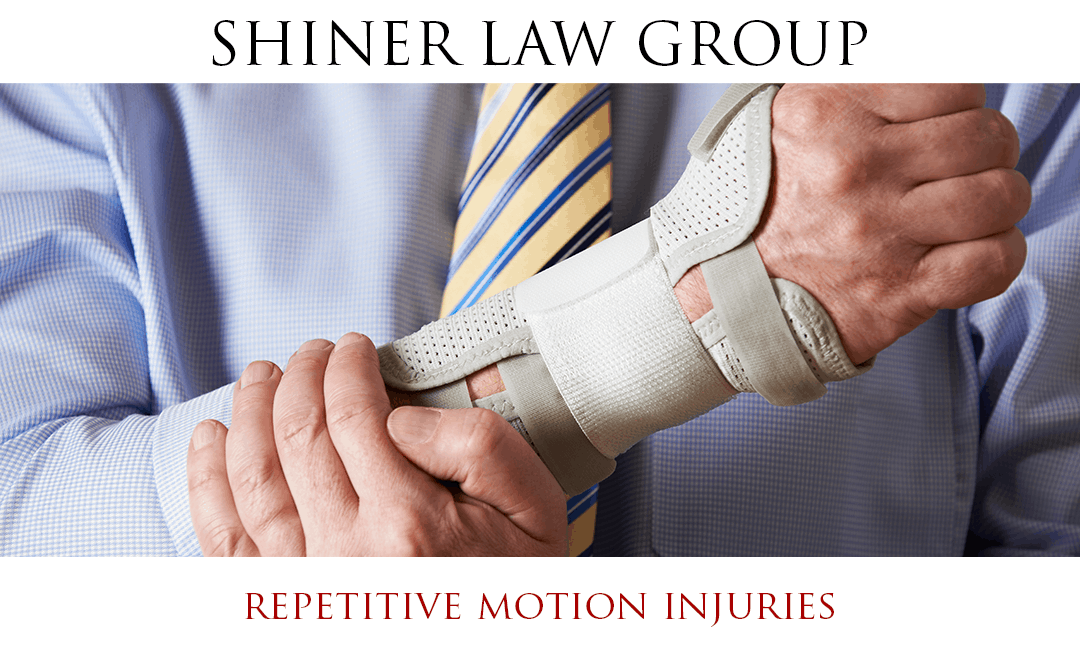Workplace injuries are usually associated with life-altering incidents like fall from heights or machine explosion. However, sometimes workplace injuries develop over time as a result of repetitive movements on the job – scanning items, typing on the keyboard for long durations, holding heavy objects, hammering nails. Fortunately, employees can get compensated for their repetitive motion injuries through workers’ compensation if they can prove that their work-related duties caused the injury.
Repetitive Motion Injuries and Their Symptoms
Repetitive motion injuries go by various names such as repetitive stress injuries, repetitive strain injuries, cumulative trauma or overuse injuries. RMIs include different conditions including:
- Raynaud’s disease
- Tendinitis
- Trigger finger
- Nerve entrapment disorders
- Dystonia
- Radia tunnel syndrome
- Tenosynovitis
- Bursitis
- Rotator cuff injuries
- Lower back pain

A repetitive motion injury may involve one or more of the following symptoms:
- Tingling
- Numbness
- Pain from tenderness
- Acute pain
- Loss of coordination or strength
- Reduced range of flexibility or motion
An individual may not notice these and other symptoms in early stages or they may only experience them when they’re doing a certain motion. Without treatment, they may eventually start experiencing weakness, pain and other symptoms more often. Even rest may not do them any good once they start experiencing symptoms of repetitive motion injuries all the time, which may leave them incapable of doing their job or performing simple actions essential for their daily life.
Who is More Likely to Suffer From a Repetitive Motion Injury?
Repetitive motion injuries are mostly associated with working at computers. Given the massive number of jobs that required require workers to use a mouse, keyboard or/and touchscreen, it is no surprise that cumulative injuries related to the use of a computer are widespread. However, there are several other tasks that can cause repetitive motion injuries.
Many factors contribute to the development of a repetitive motion injury. When workers perform tasks that aren’t suited for their body, it can cause wear and tear and excessive strain on tendons and muscles. For example, if a person works on an assembly line every day and has to lean or stretch across the conveyor belt constantly, it could affect muscles in their back, neck, and arms. Our body isn’t meant to overstretch in awkward positions for hours. It can create damage to the structures of our body, which may lead to conditions like repetitive motion injury.
In addition to performing repetitive tasks and overusing muscles, other factors that may contribute to repetitive motion injuries include:
- Adopting awkward postures
- Holding static postures for hours
- Using vibrating equipments
- Performing forceful movements
- Performing repetitive tasks
- Using equipment that is poorly designed
- Working in environments that aren’t ergonomically sound
- Heavy lifting
- Lifting awkwardly shaped items
Some examples of occupations where workers are at risk of developing a repetitive motion injury include:
- Delivery work
- Plumbing and pipefitters
- Healthcare workers
- Cashiers
- Housekeeping cleaners and janitors
- Clerks
- Meat processing workers
- Agricultural workers
- Firefighters
- Construction workers
- Mechanics
- Bus drivers and truck drivers
Maintain Proper Posture to Avoid Repetitive Motion Injuries
Workers must maintain proper posture to minimize stress on their body and reduce the risk of developing a repetitive motion injury. This applies to all jobs, but it is particularly important for people working desk jobs that involve typing all day. Employees who have to sit all day at work should check to ensure that they are using the right posture.
Optimize Your Workstation
Employees should also make their workstations ergonomically sound. Here are some tips they can use to optimize their workstation.
- Adjust the keyboard so that it is approximately 4 to 6 inches from the desk’s front edge.
- Position the mouse near the keyboard so that arms don’t have to be stretched for reaching it.
- The screen should be roughly at the same height as their eyes. If it is too low or too high, it’ll cause them to tilt their head downwards or backward placing stress on their neck.
What to Do if You Suspect a Repetitive Motion Injury
If you think that you’re developing a repetitive motion injury, you shouldn’t put off getting yourself checked out. Delaying treatment will make matters worse, so don’t wait to get yourself examined.
However, before you go to a physician, inform your employer. Your employees cannot attempt to fix or change working conditions if they aren’t aware of your work-related repetitive motion injury and the job duties that caused the problem. Moreover, some states mandate workers to use a company physician for work-related conditions and injuries.
So, tell your employer/manager about the symptoms. If repetitive motion injury is work-related, you may be able to receive workers’ compensation benefits. But, for that, you’ll need to inform your employer so that a claim can be filed on time and your treatment can be covered.
Workers’ Compensation for a Repetitive Motion Injury
Generally, repetitive motion injuries are covered under the workers’ compensation coverage. However, in some states, there are special limits on these injuries and employees may be required to meet higher standards to prove that their injury was caused by work-related duties.
The deadline for filing workers’ compensation claims vary depending on the state. In case of repetitive motion injury, the period generally starts from when a worker first starts experiencing some disability and they know that it resulted from their work duties.

Seeking Help For Repetitive Injuries
If your employee denies your workers’ compensation claim for a repetitive motion injury, you should speak with an experienced attorney at Shiner Law Group. Repetitive motion injuries are more complicated than other work-related injuries and it can be hard to prove that the work duties caused the injury. Therefore, it would be best to have an experienced accident attorney on your side to navigate you through the workers’ compensation claim.